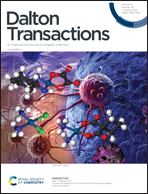A novel star-shaped trinuclear platinum(ii) complex based on a 1,3,5-triazine core displaying potent antiproliferative activity against TNBC by the mitochondrial injury and DNA damage mechanism†
Abstract
Polynuclear platinum(II) complexes represent a class of great prospective Pt-based antitumor drugs that may expand the antitumor spectrum and overcome the clinical problems of drug resistance and side effects of platinum-based drugs. Herein, a novel star-shaped trinuclear platinum(II) complex [Pt3(L–3H)Cl3] (1, L = 2,4,6-tris[(2-hydroxybenzyl)(2-pyridylmethyl)amine]-1,3,5-triazine) and its monomer [Pt(L′–H)Cl] (2, L′ = (2-hydroxybenzyl)(2-pyridylmethyl)amine) were synthesized and characterized. The in vitro antiproliferative activities of complexes 1 and 2 against a panel of human cancer cell lines including MDA-MB-231 (triple-negative breast cancer, TNBC), MCF-7 (breast), HepG-2 (liver), and A549 (lung) were investigated. The results revealed that 1 exhibited much higher antiproliferative properties than its monomer 2 against the tested cell lines. Importantly, 1 possessed 3.3-fold higher antiproliferative activity as compared with cisplatin against the TNBC cell line MDA-MB-231. Another TNBC cell line MDA-MB-468 is also sensitive to 1. The results indicated that 1 might have the potential to act as a candidate for the treatment of TNBC. Cellular uptake and distribution studies showed that 1 could pass through the membrane of cells and enter into cells and mainly accumulate in the nuclei and mitochondria. 1 could bind to DNA in a cooperative groove-electrostatic-platinating binding mode and induce stronger DNA double-strand breaks (DSBs) and damaging effects on MDA-MB-231 than cisplatin (upregulation of γ-H2AX). Moreover, the DNA damage could not be easily repaired (upregulation of p53), which would exert a much positive influence on the overcoming of drug resistance. Additionally, flow cytometry studies showed that 1 arrested the cell cycle in the G0/G1 phase, induced mitochondrial membrane depolarization, increased ROS generation, and induced cell apoptosis. The results demonstrated that 1 could target simultaneously mitochondria and nuclei that gave rise to mitochondrial injury and DNA damage and ultimately efficiently promote the apoptotic death of tumor cells. Further mechanistic studies showed that 1 induced MDA-MB-231 cell apoptosis via the p53-mediated mitochondrial pathway by upregulating Bax and cytochrome c and downregulating Bcl-2 proteins, leading to the activation of caspase-3 and upregulation of the cleaved-PARP level. Taken together, 1 with such a synergic mechanism has great potential to be an effective anticancer agent that can overcome treatment resistance in TNBC.



 Please wait while we load your content...
Please wait while we load your content...